| Life Cycle: Mating |
One night I watched a moth land in some foliage of
a Pokeweed plant in a flower border about 20 ft. from my mercury vapor
lamp. Using my headlamp I found it clinging to the underside of a leaf
about 2 ft. above the ground. I decided to get my camera, set it in
flash mode, and was trying to decide on the best angle for photographs
when I notice movement near the ground beneath the group of tall plants.
It was a moth fluttering back and forth as if it couldn't decide which
way it wanted to go. I didn't realize that I was observing a female
"calling" a male by releasing pheromone "sex attractant." When the
fluttering moth got a good whiff of the pheromone he beelined it to land
right beside the female. In what seemed like a blink-of-the-eye, no more
than 2-3 seconds, I saw a brief movement of abdomens and then the male
fell backward off the leaf. He didn't fall far, however, but swung like
a pendulum a few time until coming rigidly to rest as seen in the photo
at right, below. They didn't seem to mind my being a few feet away or
the sounds of the camera or the flash. They remained in this position
for at least 30 minutes, but were gone a couple of hours later when I
thought to look for them again.
|
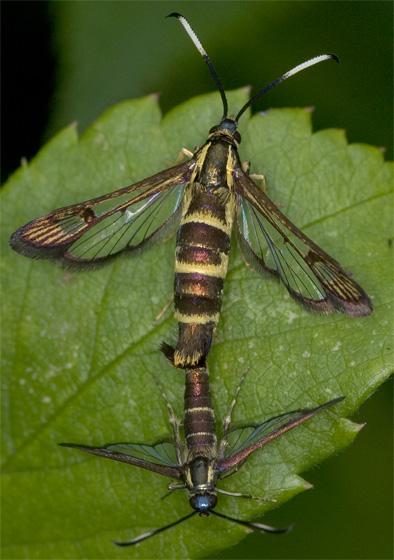 Carmenta ithacae [tentative] Carmenta ithacae [tentative]
© Tam Stuart |
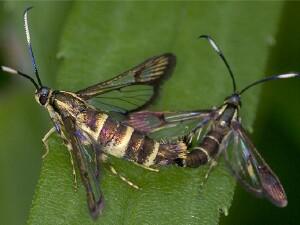 Carmenta ithacae [tentative] Carmenta ithacae [tentative]
© Tam Stuart |
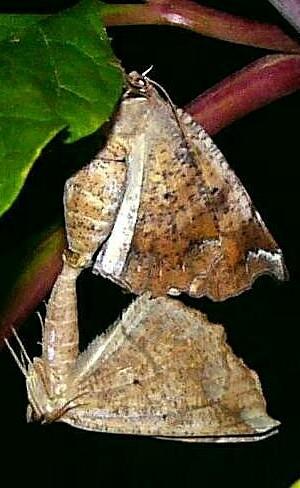 Curve-toothed
Geometer Curve-toothed
Geometer
© Robert Patterson |
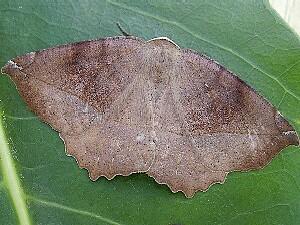 Curve-toothed Geometer Curve-toothed Geometer
© Machele White
| |
Tam Stuart's photos of the Clearwing Moths reveal the
frequent disparity in size between males (usually smaller) and females.
In the top center photo the pair have just made genital contact. They
then flew in tandem, the female leading and in control, to a nearby leaf
where the female is in the typical "superior" position (left, above). A
short movie requiring Macromedia Flash Player shows a male's
approach to a female, genital connection, and fall-away to final
position of Grape-root Borer Moths, Vitacea polistiformis, at John
Meyer's ENT425 page on Chemical Communication. In this case there
seems to have been a few seconds of excited stimulatory behavior on the
part of the male.
|
| Life Cycle: Diapause, Aestivation and Overwintering
|
Diapause, Aestivation and Overwintering/Hibernation
all refer to periods of inactivity. Aestivation or Overwintering refer
to inactive periods in the adult stage of the moth life cycle. On the
other hand, diapause is a halt or pause somewhere in the development
process of the egg, larva or pupa. The pause can be relatively short or
long. In the case of the Eastern Tent Caterpillar Moth, Malacosoma
americanum, the eggs laid in the spring develop to the point where
the first instar larvae are about ready to hatch. The larvae then go
into diapause (still within the egg) for a period of 9.5-10.5 months,
waiting for their primary food, leaves of forest trees, to leaf out. The
data for the chart shown below is for Alabama but, except for the
beginning and ending dates for each life stage, would look just about
the same for more northerly areas. The lengths of each stage would be
similar. Note that this species spends less than 10% of the life cycle
in the adult stage.
|
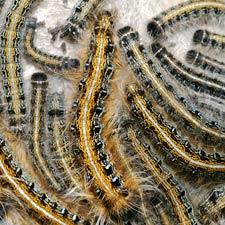 © Nolie Schneider © Nolie Schneider
|
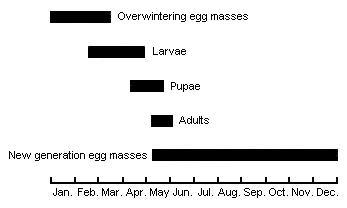 Eastern
Tent Caterpillar Life Cycle Eastern
Tent Caterpillar Life Cycle
© Lacy L. Hyche, Auburn Univ.,
www.forestryimages.org |
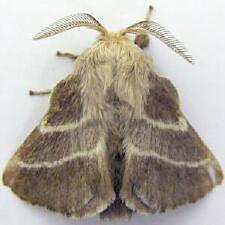 © Robert Patterson © Robert Patterson
| |
Illustrating diapause in the larval stage is
difficult. The caterpillar will simply be inactive (although often able
to move if touched or disturbed) and might appear to be somewhat
shrunken or shriveled up. Adult moths may aestivate during a period of
heat or cold and spend a considerable period of time hidden in leaf
litter, under the bark of a tree or in a tree cavity (or in modern
analogues such as sheds or under siding). We wouldn't expect to see any
real difference between aestivating moths and ones active at a light
sheet except that they would be at some location where they can be
inactive and not exposed to harsh climate. Here are some moths known to
take shelter in caves. Two of them are covered by droplets of moisture
due to the ambient air having reached the dew point. See the paper Hop
Vine Moths, Hypena humuli in a Wisconsin Cave.
|
|
|